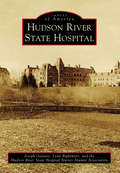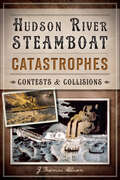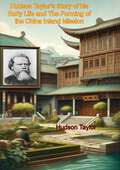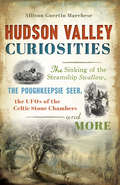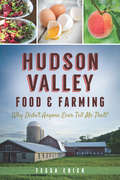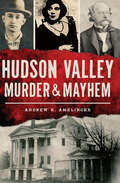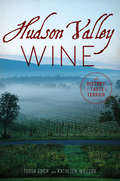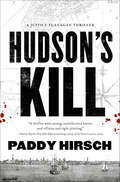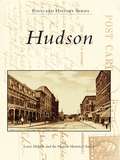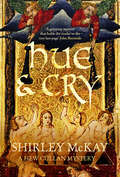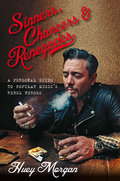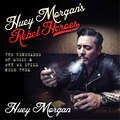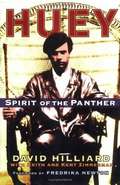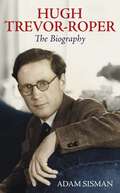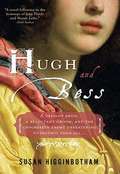- Table View
- List View
Hudson River State Hospital (Images of America)
by Joseph Galante Lynn Rightmyer the Hudson River State Hospital Nurses Alumni AssociationFor 141 years, Hudson River State Hospital was home to tens of thousands of individuals suffering from mental illness. The facility grew from a 208-acre parcel in 1871 with seven patients to 752 acres with five dozen separate buildings containing nearly 6,000 patients in 1954. The main building was constructed on a Kirkbride plan, a treating philosophy centered around an ornate building of equal proportions staffed by employees who integrated dignity and compassion into health care. Famous architects Frederick Clark Withers and Calvert Vaux drafted the main building in 1869. The landscape was penned by Frederick Law Olmstead, perhaps best known for the design of New York City's Central Park.
Hudson River Steamboat Catastrophes: Contests and Collisions (Disaster)
by J. Thomas AllisonBeginning in the mid-1800s, steamboats carried people between New York City and the Albany area on the Hudson River. Romantic images lull us into believing it was a quiet means of travel, but a crowded river, faulty equipment and the bravado of the captains resulted in at least one major catastrophe every year. Night boats collided and sank, carelessness caused boiler explosions, races put passengers at risk and fires would quickly swallow the wooden vessels. The grand "Empire of Troy "suffered many collisions. The "Swallow" broke in two on a rock, "Reindeer"'s explosion took forty lives at once and the "Oregon" and "C. Vanderbilt" entered into an epic and dangerous race. Collected from eyewitness accounts, these are some of the most exciting and frightening stories of peril aboard steamboats on the Hudson River.
Hudson River Valley Farms: The People And The Pride Behind The Produce
by Joanne MichaelsMeet your local farmer! Published for the 400th anniversary of Henry Hudson&’s September 1609 journey along the river that today bears his name, this fascinating illustrated portrait celebrates the local farms—and farmers—in one of the country&’s most scenic and storied regions, once known as the Breadbasket of America. Hudson River Valley Farms brings to life the renaissance of food producers who have developed the region as a source of artisanal cheeses, grass-fed beef, and first-rate organic fruits and vegetables. Stunning photography and short, evocative essays take you on a rare, behind-the-scenes journey to forty-four farms from Westchester County to the Capital District of Albany, and include the colorful maverick entrepreneurs behind the striking scenery. The book also includes a directory of nearly 100 local farmers&’ markets, directions to the featured farms, and an introduction by the region&’s popular U.S. Congressman, Maurice Hinchey.
Hudson Taylor's Story of his Early Life and The Forming of the China Inland Mission
by J. Hudson Taylor"Hudson Taylor's Story of His Early Life and the Forming of the China Inland Mission" is an inspiring and deeply moving account of the early years of one of the most influential missionaries in history. This book chronicles the formative experiences and profound spiritual journey of James Hudson Taylor, a pioneering figure whose faith and determination led to the establishment of the China Inland Mission (CIM).The narrative begins with Taylor's humble beginnings in England, exploring the events and influences that shaped his character and ignited his passion for missionary work. From his early struggles and profound religious experiences to his unwavering commitment to evangelism, Taylor's story is one of resilience, faith, and visionary leadership.Taylor's journey to China is recounted with vivid detail, capturing the challenges he faced, including cultural barriers, language difficulties, and personal hardships. Despite these obstacles, his steadfast belief in his mission and his innovative approach to cross-cultural ministry set the stage for his enduring legacy.The book details the founding principles of CIM, emphasizing its commitment to reaching the inland provinces of China with the Christian message. Taylor's innovative methods, including the recruitment and training of missionaries, his focus on self-reliance, and his unwavering faith in divine provision, are explored in depth."Hudson Taylor's Story of His Early Life and the Forming of the China Inland Mission" is more than a biography; it is a powerful testament to the impact of faith-driven determination and cross-cultural engagement. It provides valuable insights into the challenges and triumphs of missionary work in 19th-century China and offers timeless lessons in perseverance, cultural sensitivity, and the transformative power of faith.
Hudson Valley Curiosities: The Sinking of the Steamship Swallow, the Poughkeepsie Seer, the UFOs of the Celtic Stone Chambers and More
by Allison Guertin MarcheseHudson Valley is steeped in mysteries, from Celtic chambers resting in the deep woods of Putnam to Millbrook�s abandoned Bennett College. In the Highlands, Iroquois chief Daniel Nimham gave his life for the cause of American independence. One strange night in the Catskills, a legendary playwright miraculously survived a midnight plunge off the suspended Schoharie Bridge. The great passenger steamship Swallow sank near the shores of Athens. Author Allison Guertin Marchese reveals a treasure-trove of curious tales recounting the most uncommon history of bad guys, bold girls, creepy colleges, missing mastodons and more in this wondrous region of New York.
Hudson Valley Food & Farming: Why Didn't Anyone Ever Tell Me That? (American Palate)
by Tessa EdickFarming has sustained the Hudson Valley for more than four hundred years. Family farms grow succulent fruits and wholesome vegetables, from corn and cabbage to apples and peaches. They raise cows, chickens and lambs and produce an array of cheese and other fresh products. Hudson Valley locavores are once again turning to neighborhood farms for the freshest foods--and in the process, they are revitalizing the local economy and preserving the rich lands that are their heritage. Author Tessa Edick and the FarmOn Foundation are at the heart of this local movement. Their work is so simple yet so impactful that you will wonder, "Why didn't anyone ever tell me that?" With stunning photographs and an insightful narrative, Edick introduces some of the most innovative and inspiring Hudson Valley farmers along with their delectable harvest.
Hudson Valley Murder & Mayhem (Murder And Mayhem Ser.)
by Andrew K. AmelinckxThe Hudson Valley&’s dark past, from Prohibition-era shoot-outs to unsolved murders, in eleven heart-pounding true stories. The beautiful Hudson Valley of New York State is drenched in history, culture . . . and blood. This fascinating and thoroughly researched chronicle presents one killer story from every county in the region, including: Sullivan County: In the fall of 1893, Lizzie Halliday left a trail of bodies in her wake, slaughtering two strangers and her husband before stabbing a nurse to death at the asylum where she lived. Albany County: A Jazz Age politician, tired of fighting with his overbearing wife, murdered her and buried the body under the front porch. Columbia County: In 1882, a cantankerous old miner, dubbed the &“Austerlitz Cannibal&” by the press, chopped up his partner before he himself swung from the end of a rope.
Hudson Valley Wine: A History of Taste & Terroir (American Palate)
by Tessa Edick Kathleen WillcoxAlthough it’s the birthplace of American wine, Hudson Valley vintages have yet to meet with the renown of those produced by the neighboring Finger Lakes and Long Island. In the 1600s, French Huguenots arrived in the area and used their French winemaking skills to found vineyards. Benmarl is cultivating astounding varietals from a vineyard that has continuously grown grapes since 1772. Recently launched cooperative winemaking organizations have made strides in the region, and scientists at Cornell University have worked to determine the tastiest varietals and hybrids that will flourish in the challenging Hudson Valley terroir. Hudson Valley wines are at last garnering critical acclaim in mainstream national publications and restaurants. Tessa Edick and Kathleen Willcox uncover the hundreds of years, unrelenting pride, determination and ingenuity behind Hudson Valley wines.
Hudson's Kill: A Justice Flanagan Thriller (Justice Flanagan #2)
by Paddy HirschSet in 1803 New York, Hudson's Kill is the riveting next historical thriller from NPR reporter and producer Paddy Hirsch, perfect for fans of The Alienist and Gangs of New York.New York in 1803 is rife with tension as the city expands, and whoever knows where the city will build can control it. And violence builds as a mysterious provocateur pits the city’s black and Irish gangs against each other. When a young black girl is found stabbed to death, both Justy Flanagan, now a City Marshal, and Kerry O’Toole, now a school teacher, decide separately to go after the killer. They each find their way to a shadowy community on the fringes of the growing city, where they uncover a craven political conspiracy bound up with a criminal enterprise that is stunning in its depravity.Justy and Kerry have to fight to save themselves and the city, and only then can they bring the girl’s killer to justice.At the Publisher's request, this title is being sold without Digital Rights Management Software (DRM) applied.
Hudson-Fulton Celebration of 1909
by Roger Panetta Edward F. LevineThe Hudson-Fulton Celebration of 1909 honored the tercentennial of Henry Hudson's great find for the Dutch and the centennial of Robert Fulton's steamboat. These events anchored settlements along the Hudson River valley and helped to define this famous region. The celebration, which coincided with the heyday of the penny postcard, was a multi-week, cross-state parade and party. Among its many vintage images, Hudson-Fulton Celebration of 1909 features unique postcards from the magnificent event by blockbuster artist Bernhardt Wall, renowned publisher Raphael Tuck, and an official souvenir series from the Redfield Brothers.
Hudson: Historically Speaking
by Diane Chubb Lynne OberHudson has a history of remarkable characters and events, fromthe young Piscataqua woman who ignited King Philip's War to a successful kitten rescue during the Great Ice Flood of 1936. Meet the distinguished patrons who shaped Hudson's legacy, such as settler Nathaniel Cross, who famously escaped Indian capture, and Dr. Alfred Hills and his wife Virginia, namesakes of the many Alvirne buildings. Relive the heyday of Benson's Animal Farm, subject of community-wide nostalgia since its closing in 1987. Authors Diane Chubb and Lynne Ober also unearth some of Hudson's darker moments, like the 1925 murder that some consider one of New Hampshire's most gruesome or the 1974 fire that engulfed Alvirne High School in a ball of flame. For residents and visitors alike, Hudson: Historically Speaking reveals this suburb's rich history of commerce, controversy, and culture.
Hudson: The Early Years, Up To 1867 (Postcard History)
by Lewis Halprin Hudson Historical SocietyHudson began in 1699 as a cluster of small industries in the northern part of the town of Marlborough, situated by the swift-flowing Assabet River. Through the years, the industries prospered and the largely immigrant workers began to bring their families to America from overseas. New homes were soon built for these families as stores, churches, and schools sprang up around town. As this factory neighborhood progressed and became self-reliant, residents petitioned the state government to become their own independent town. Because of their efforts, the town of Hudson was incorporated in 1866.
Hue & Cry: A Hew Cullen Mystery (The Hew Cullan Mysteries #1)
by Shirley McKayIntroducing sixteenth-century Scottish lawyer and amateur sleuth Hew Cullan in &“a gripping mystery that holds the reader to the very last page&” (John Burnside, prize-winning poet and novelist). 1579, St Andrews. A thirteen-year-old boy meets his death on the streets of the university city of St Andrews, and suspicion falls upon one of the regents at the university, Nicholas Colp. Hew Cullan, a young lawyer recently returned home from Paris, uncovers a complex tale of passion and duplicity, of sexual desire in conflict with the repressive atmosphere of the Protestant Kirk and the austerity of the academic cloister. Praise for the Hew Cullan Mysteries &“Charms the reader.&” —Scotland on Sunday &“The authentic Scottish dialogue and gripping narrative make this a must for fans of Scottish history or mystery.&” —Scottish Field &“Wonderful stuff.&” —Good Book Guide &“Informative, suspense filled, downright entertaining.&” —The Bookbag
Hue 1968: A Turning Point of the American War in Vietnam
by Mark BowdenThe author of Black Hawk Down vividly recounts a pivotal Vietnam War battle in this New York Times bestseller: “An extraordinary feat of journalism”. —Karl Marlantes, Wall Street JournalIn Hue 1968, Mark Bowden presents a detailed, day-by-day reconstruction of the most critical battle of the Tet Offensive. In the early hours of January 31, 1968, the North Vietnamese launched attacks across South Vietnam. The lynchpin of this campaign was the capture of Hue, Vietnam’s intellectual and cultural capital. 10,000 troops descended from hidden camps and surged across the city, taking everything but two small military outposts.American commanders refused to believe the size and scope of the siege, ordering small companies of marines against thousands of entrenched enemy troops. After several futile and deadly days, Lieutenant Colonel Ernie Cheatham would finally come up with a strategy to retake the city block by block, in some of the most intense urban combat since World War II.With unprecedented access to war archives in the United States and Vietnam and interviews with participants from both sides, Bowden narrates each stage of this crucial battle through multiple viewpoints. Played out over 24 days and ultimately costing 10,000 lives, the Battle of Hue was by far the bloodiest of the entire war. When it ended, the American debate was never again about winning, only about how to leave.A Los Angeles Times Book Prize Finalist in HistoryWinner of the 2018 Marine Corps Heritage Foundation Greene Award for a distinguished work of nonfiction
Huesos sin descanso
by Cristóbal MarínCristóbal Marín nos entrega una absorbente e ilustrativa crónica sobre los habitantes de Tierra del Fuego, sus distintos viajes por Londres y Europa y el destino de sus restos mortales. A partir de una experiencia personal con la taxidermia, y rodeado de anécdotas sobre el traslado de huesos (familiares y ajenos), Cristóbal Marín narra en esta crónica las peripecias de su viaje en búsqueda de información sobre el paradero y destino de los fueguinos que murieron tanto en Londres como Europa durante el siglo XIX luego de ser expuestos en zoológicos humanos y ferias o llevados, siempre contra su voluntad, para ser analizados por científicos y anatomistas y, en algunos casos, educados en los valores occidentales con el propósito de que regresara "civilizados" a sus tierras. Con un estilo digresivo, que va de una historia a otra, vinculando temas que parecieran ser diferentes (históricos y personales), Marín logra armar un mapa y reconstruir los viajes de ingleses a Tierra del Fuego (desde Charles Darwin a Bruce Chatwin) y de los selk'nam, yaganes y kawésqar por distintas ciudades europeas. ¿El resultado? Una entretenida errancia por Tierra del Fuego, Londres y Berlín que entrega al lector un apasionante como erudito ensayo literario.
Huey Morgan's Rebel Heroes: The Renegades of Music & Why We Still Need Them
by Huey MorganThe defining sounds of popular music - blues, rock 'n' roll, punk, hip-hop - were shaped and driven by rebel voices: whether that was Robert Johnson and Billie Holiday in the 1920-40s, or the likes of Jimi Hendrix, Janis Joplin and Joe Strummer in the 1960s and 70s. Truly ground- and rule-breaking voices have been drowned out by pop-by-numbers acts in more recent years, and in Rebel Heroes, Huey Morgan investigates where music started to lose its soul, and why the lessons of those renegade spirits of yesteryear are still so vital. The book is steeped in Huey's love for, and knowledge of, music and is full of personal anecdotes and stories of some of the greatest musicians to have graced us with their talent.
Huey Morgan's Rebel Heroes: The Renegades of Music & Why We Still Need Them
by Huey MorganThe defining sounds of popular music - blues, rock 'n' roll, punk, hip-hop - were shaped and driven by rebel voices: whether that was Robert Johnson and Billie Holiday in the 1920-40s, or the likes of Jimi Hendrix, Janis Joplin and Joe Strummer in the 1960s and 70s. Truly ground- and rule-breaking voices have been drowned out by pop-by-numbers acts in more recent years, and in Rebel Heroes, Huey Morgan investigates where music started to lose its soul, and why the lessons of those renegade spirits of yesteryear are still so vital. The book is steeped in Huey's love for, and knowledge of, music and is full of personal anecdotes and stories of some of the greatest musicians to have graced us with their talent.(p) 2015 Octopus Publishing Group
Huey Morgans Rebel Heroes: The Renegades Of Music And Why We Still Need Them
by Huey MorganThe defining sounds of popular music - blues, rock 'n' roll, punk, hip-hop - were shaped and driven by rebel voices: whether that was Robert Johnson and Billie Holiday in the 1920s and 30s, or the likes of Hendrix, Janis Joplin and Joe Strummer in the 1960s and 70s. In more recent years those truly ground- and rule-breaking voices have been harder to hear, and in Sinners, Chancers & Renegades, Huey Morgan shines a spotlight on the rebel spirits of music in the last century and looks at why there are so few around today. The book includes personal anecdotes from Huey of his experiences listening to these artists as a child, and of meeting - and in some cases playing with - some of them as a musician himself in later years.
Huey P. Long Bridge
by Jennifer Snape Tonja Koob MarkingNamed after the 40th governor of Louisiana, the Huey P. Long Bridge, just outside of New Orleans in Jefferson Parish, is the longest railroad bridge in the United States. For 15 years after it opened in 1935, it was the longest railroad bridge in the world. Initially conceived in 1892, the "Huey P." was the first bridge to span the deep-draft navigation channel of the lower Mississippi River, opening the path for a southern transcontinental railroad. The highway and pedestrian portions of the bridge provided additional transport, which previously had only been available by ferry. New Orleans and its surrounding regions grew in population and economic importance as the publicly owned bridge connected the Port of New Orleans to the rest of the United States through six Class I railroads. The Huey P. continues to function in its original, now undersized, capacity. In April 2006, the state began a widening of the bridge to double its automobile lanes from 18 feet to 43 feet. In September 2012, the American Society of Civil Engineers dedicated the Huey P. Long Bridge as a Historic Civil Engineering Landmark.
Huey P. Newton: The Radical Theorist
by Judson L. JeffriesHuey P. Newton's powerful legacy to the Black Panther movement and the civil rights struggle has long been obscured. Conservatives harp on Newton's drug use and on the circumstances of his death in a crack-related shooting. Liberals romanticize his black revolutionary rhetoric and idealize his message. In Huey P. Newton: The Radical Theorist, Judson L. Jeffries considers the entire arc of Newton's political role and influence on civil rights history and African American thought. Jeffries argues that, contrary to popular belief, Newton was one of the most important political thinkers in the struggle for civil rights. Huey P. Newton's political career spanned two decades. Like many freedom fighters, he was a complex figure. His international reputation was forged as much from his passionate defense of black liberation as from his highly publicized confrontations with police. His courage to address police brutality won him admirers in ghettos, on college campuses, and in select Hollywood circles. Newton gave Black Power a compelling urgency and played a pivotal role in the politics of black America during the 1960s and 1970s. Few would deny that Newton's life (1942-1989) was strewn with incidences of violence and that his police record was long. But Newton's struggles with police took place in a rich and troubled context that included urban unrest, police brutality, government repression, and an intense debate over civil rights tactics. Stripped of history and interpretation, the violence of Newton's life brought emphatic indictments of him. Newton's death attracted widespread media attention. However, pundits offered little on Newton as freedom fighter or as theoretician and activist. Huey P. Newton: The Radical Theorist dispels myths about Newton's life, but the book is primarily an in-depth examination of Newton's ideas. By exploring this charismatic leader, Jeffries's book makes a valuable contribution to the scant literature on Newton, while also exposing the core tenets and evolving philosophies of the Black Panther Party.
Huey: Spirit of the Panther
by David L. Hilliard Keith Zimmerman Kent ZimmermanHuey P. Newton remains one of the most misunderstood political figures of the twentieth century. As co-founder and leader of the Black Panther Party for more than twenty years, Newton (1942-1989) was at the forefront of the radical political activism of the 1960s and '70s. Raised in poverty in Oakland, California, and named for corrupt Louisiana governor Huey P. Long, Newton embodied both the passions and the contradictions of the civil rights movement he sought to advance. In this first authorized biography, Newton's former chief of staff David Hilliard teams up with best-selling authors Keith and Kent Zimmerman to tell the whole story of the man behind the organization that FBI director J. Edgar Hoover infamously dubbed "the greatest threat to the internal security of the country."
Hugh Despenser the Younger and Edward II: Downfall of a King's Favourite
by Kathryn WarnerHugh Despenser the Younger and Edward II tells the story of the greatest villain of the fourteenth century, his dazzling rise as favorite to the king and his disastrous fall.Born in the late 1280s, Hugh married King Edward I of Englands eldest granddaughter when he was a teenager. Ambitious and greedy to an astonishing degree, Hugh chose a startling route to power: he seduced his wifes uncle, the young King Edward II, and became the richest and most powerful man in the country in the 1320s. For years he dominated the English government and foreign policy, and took whatever lands he felt like by both quasi-legal and illegal methods, with the kings connivance. His actions were to bring both himself and Edward II down, and Hugh was directly responsible for the first forced abdication of a king in English history; he had made the horrible mistake of alienating and insulting Edwards queen Isabella of France, who loathed him, and who had him slowly and grotesquely executed in her presence in November 1326.
Hugh Trevor-Roper
by Adam SismanHugh Trevor-Roper's life is a rich subject for a biography - with elements of Greek tragedy, comedy and moments of high farce. Clever, witty and sophisticated, Trevor-Roper was the most brilliant historian of his generation. Until his downfall, he seemed to have everything: wealth and connections, a chair at Oxford, a beautiful country house, an aristocratic wife, and, eventually, a title of his own. Eloquent and versatile, fearless and formidable, he moved easily between Oxford and London, between the dreaming spires of scholarship and the jostling corridors of power. He developed a lucid prose style which he used to deadly effect. He was notorious for his acerbic attacks on other historians, but ultimately tainted his own reputation with a catastrophic error when he authenticated the forged 'Hitler Diaries'. Adam Sisman sheds new light on this fascinating and dramatic episode, but also shows that there was much more to Hugh Trevor-Roper's career than the fiasco of the Hitler Diaries hoax that became his epitaph. From wartime code-breaking to grilling Nazis while the trail was still fresh in 1945 (and finding Hitler's will buried inside a bottle), to his wide-ranging interests, his snobbery and his malice, his formidable post-war feuds with Evelyn Waugh, Tawney, Toynbee, Taylor and many others, and his secret and passionate affair with an older, married woman. A study in both success and failure, Adam Sisman's biography is a revealing and personal story of a remarkable life.
Hugh and Bess
by Susan Higginbotham"A delightful novel full of chivalry, romance, and real-life terrors. " Historical Novels Review
Hugh of Amiens and the Twelfth-Century Renaissance (Church, Faith and Culture in the Medieval West)
by Ryan P. FreeburnHugh of Amiens (c. 1085-1164) was an important intellectual figure in the twelfth century. During a long life he served as a cleric, Cluniac monk, abbot, and archbishop of Rouen. He wrote a number of works including poems, biblical exegesis, anti-heretical polemics, and most importantly one of the earliest collections of systematic theology, his Dialogues. This book examines all of Hugh's writings to uncover a better understanding not only of this individual, but also of the twelfth-century as a whole, especially the theological preoccupations of the period, including the development of systematic theology and views on the differences of the monastic and clerical ways of life.
